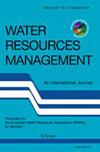非均质沿海含水层倾斜截流墙控制海水入侵效果评价
IF 4.7
3区 环境科学与生态学
Q1 ENGINEERING, CIVIL
引用次数: 0
摘要
地下物理屏障已被有效地用于缓解海水入侵。传统上,数值研究和实际实施的主要重点是垂直屏障。本研究旨在通过实验和数值模拟两种方法,探讨不同截流壁倾角和深度下SWI的动态变化,以及含水层的非均质性。通过使用低导水率(K)含水层(案例L)、高导水率含水层(案例H)和两个分层含水层来评估含水层特征的影响。分层含水层是通过将不同的导水性层分为两种情况:高钾高于低钾(案例H/L)和低钾高于高钾(案例L/H)而形成的。模型模拟了45.0°、63.4°、76.0°、90.0°、104.0°、116.6°和135.0°7种不同的截止壁倾角。当截流壁深比达到0.623时,SWI楔形长度的最大斥力比为76.0°。然而,当深度比增加到0.811时,所有含水层的最大斥力比都变为63.4°。在倾斜切断深度比为0.811时,切断壁倾角为45.0°对咸水楔面积的影响最为显著。这导致病例L、病例H、病例H/L和病例L/H的SWI面积分别减少74.9%、79.8%、74.7%和62.6%。本研究为SWI的预防提供了实用的见解。然而,全面的成本效益分析是必要的,以评估建设倾斜截流墙的可行性。本文章由计算机程序翻译,如有差异,请以英文原文为准。
Evaluating the Impact of Inclined Cutoff-Wall to Control Seawater Intrusion in Heterogeneous Coastal Aquifers
Abstract Subsurface physical barriers have been effectively used to mitigate seawater intrusion (SWI). Traditionally, the primary emphasis in both numerical studies and practical implementations has been on vertical barriers. The current research aims to explore the dynamics of SWI under various cutoff-wall inclination angles and depths, as well as aquifer heterogeneity using both experimental and numerical simulations. The impact of aquifer characteristics was assessed by utilizing a low hydraulic conductivity (K) aquifer (case L), a high hydraulic conductivity aquifer (case H), and two stratified aquifers. The stratified aquifers were created by grouping different hydraulic conductivity layers into two cases: high K above low K (case H/L) and low K above high K (case L/H). The model simulations covered seven different cutoff-wall inclination angles: 45.0°, 63.4°, 76.0°, 90.0°, 104.0°, 116.6°, and 135.0°. The maximum repulsion ratio of SWI wedge length was observed at an inclination angle of 76.0° for cutoff-wall depth ratios up to 0.623. However, as the depth ratio increased to 0.811, the maximum repulsion ratio shifted to an angle of 63.4° for all aquifers studied. At an inclined cutoff depth ratio of 0.811, the cutoff-wall inclination angle of 45.0° had the most significant impact on the saltwater wedge area. This results in SWI area reductions of 74.9%, 79.8%, 74.7%, and 62.6% for case L, case H, case H/L, and case L/H, respectively. This study provides practical insights into the prevention of SWI. Nevertheless, a thorough cost–benefit analysis is necessary to assess the feasibility of constructing inclined cutoff-walls.
求助全文
通过发布文献求助,成功后即可免费获取论文全文。
去求助
来源期刊

Water Resources Management
环境科学-工程:土木
CiteScore
7.40
自引率
16.30%
发文量
332
审稿时长
9 months
期刊介绍:
Water Resources Management is an international, multidisciplinary forum for the publication of original contributions and the exchange of knowledge and experience on the management of water resources. In particular, the journal publishes contributions on water resources assessment, development, conservation and control, emphasizing policies and strategies. Contributions examine planning and design of water resource systems, and
operation, maintenance and administration of water resource systems.
Coverage extends to these closely related topics: water demand and consumption; applied surface and groundwater hydrology; water management techniques; simulation and modelling of water resource systems; forecasting and control of quantity and quality of water; economic and social aspects of water use; legislation and water resources protection.
Water Resources Management is supported scientifically by the European Water Resources Association, a scientific and technical nonprofit-making European association.
 求助内容:
求助内容: 应助结果提醒方式:
应助结果提醒方式:


